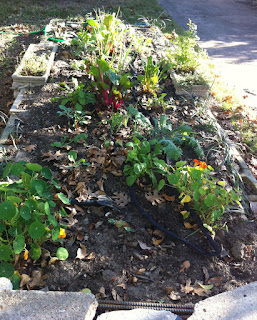So, it's been in the news lately that Brad Pitt has Stopped Using Soap & Shampoo
 |
| My unwashed hair after 2 weeks. |
Most articles and reports I've seen or heard have been silly gossip and ignorance, so don't bother looking for them. But the fact is that we don't need all these chemical products we've been convinced to buy use, wash down the drain into our waterways and then dump the packaging into our landfills. Then buy more products to restore our skin & hair after the harm the cleansers did, wash down the drain into waterways, discard packaging into landfills, repeat.
I've come to the conclusion that nearly every product in the skin & hair care aisle is there to treat a problem caused by some other product in the same aisle. Not only do we not need them, they are bad for us.
Let Your Skin Function
As I've explained in my last post, your skin isn't dead leather & your sebum isn't dead grease. They are ecosystems for enzymes and other substances that play vital roles in skin function. Your sebum contains living cells that produce these substances. It protects and exfoliates. It inhibits DHT production which is a major factor in oily skin, acne and male pattern baldness. It inhibits melatonin reducing hyperpigmentation, It produces retinoids & ceramides. All those things you pay big money for in moisturizers & creams. Ceramides & other lipids are also stripped away by cleansers. Stripping your skin of all these things makes it hard for skin to function and causes the problems we then try to solve with more products.
I haven't used soap for anything but hand washing in about 2 years. Maybe 3. I didn't write it down. I am still constantly surprised by how soft my skin is and how much better it looks. And I get frequently comments on my lovely skin, which as a lifelong acne sufferer, always surprise me. Sure, my skin is clear now, and it's not dry, flaky or wrinkled, but lovely? And comment worthy? That surprises me. (Reminder: No one looks as critically at your every flaw like you do! The don't even see those things you think are so horrible.)
And before you tell me how you have such oily skin this couldn't work for you, let me tell you, nobody has oilier skin and hair than I had. Nobody. At least not back before my diet changes cleared my skin and made it just a bit on the oily side.
Now, not only do I not smell, I've had people ask me what perfume I was wearing. And I don't wear perfume. Perfumes give me headaches or make me nauseous. Sometimes both. I use only a bit of oil and aloe vera for daily topical treatments. The only thing she could have been smelling was my hair conditioner I was using at that time, which couldn't possibly compete with a foul body odor if I had one.
Which brings me to my next stage. No Shampoo.
My No Shampoo Story: Let Sebum be your Conditioner
 |
| Same hair in the best selfie I could do. I'm so not photogenic |
But those weeks without washing got me thinking of going water only. I'd started bathing my dog with water only as he has skin problems too and I didn't want to impair his skin function. It works pretty well for him. It removes the doggy odor and left his fur feeling clean & soft. Plus it's a lot faster, getting this horrible punishment over with quicker and eliminating the risk of not getting all the soap rinsed out causing itchier skin. I wanted that too.
So, 4 weeks ago, I stopped using the baking soda and have only done water only. I first went two weeks without washing. And let me tell you, it gets bad. Just put your hair up and get through it, because it miraculously gets better. For me it was bad for a couple of days near the end of the week. Really waxy & greasy. but about day 6 I woke up with lovely hair. By lovely, I mean it's shiny. It has body, something I've never had. It's not flyaway or frizzy. It seems thicker. And it doesn't tangle and I have always had horribly tangly hair. I don't need conditioner, yet it's manageable all the time. I can get out of bed and just comb into place with my fingers. Now, it's not what I used to call clean, but since I'd been washing every three days and being a bit oily on that third day, I've adjusted that perception.
Now, here's my problem. After 2 weeks including a week of lovely hair, I washed water only & had to go through the whole thing again with the really bad greasy period. Now, I did wash with very hot water as it's winter, my bathroom is cold and my tile tub surround just radiates cold at me. I can't stop myself from turning the temperature up in the shower. I'm considering the conditioner only wash. Or washing in tepid water in the sink or kneeling outside the tub with the sprayer. I'm hoping to wash water only once a week or whenever needed to remove airborne soils & smells without going through the greasy period.
However, today it's time to color my hair again. So that's my experiment for the next two weeks. To see how my hair responds to that. The conditioner only will have to be a couple of weeks from now. The goal is to wash water only once a week or whenever needed to remove airborne soils & smells without going through the greasy period. I'll keep you informed.






